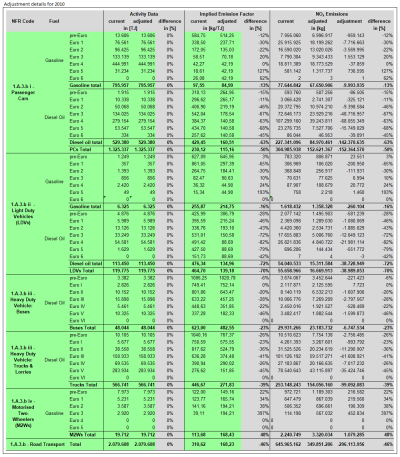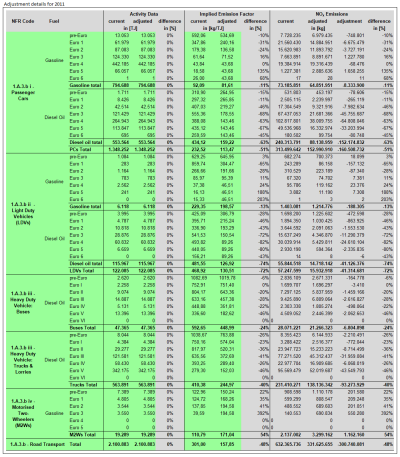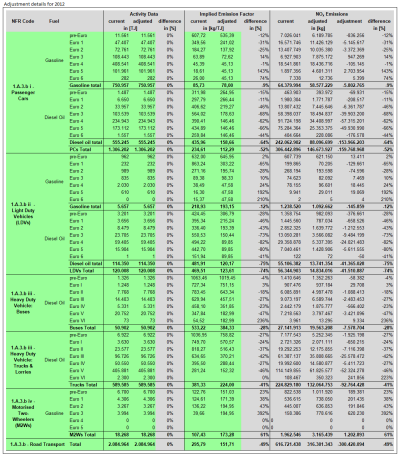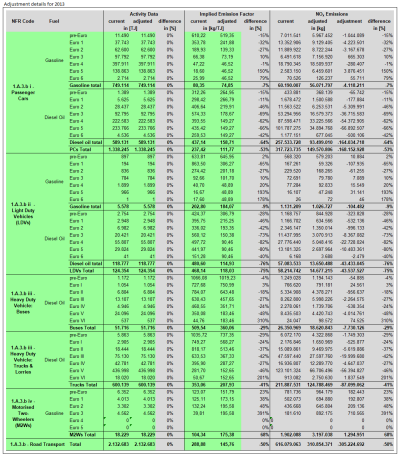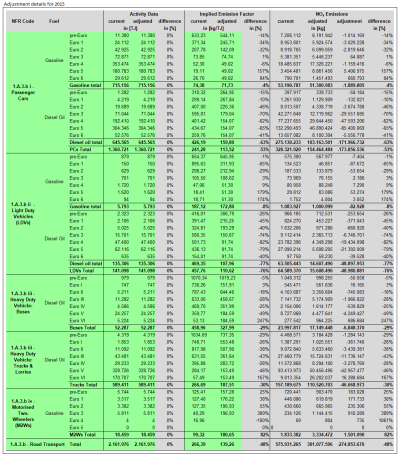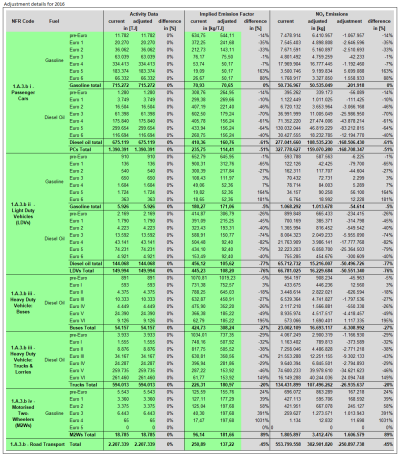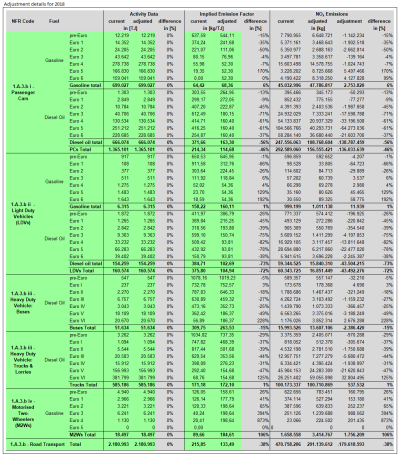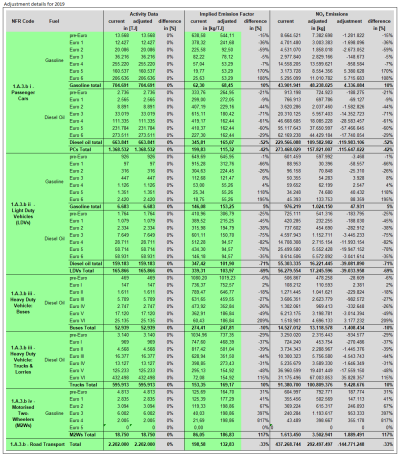meta data for this page
Adjustment DE-A regarding NOx from Road Vehicles
PREFACE
When deriving proposals for national emission ceilings for negotiations of the 1999 Gothenburg Protocol, sector-specific emission estimates for the year 2010 were calculated at IIASA using a set of scenarios which assumed various technological abatement measures, policy incentives, and legislation available / in place or planned at that time. As a result, the 2010 emission by road transport in Germany was estimated at NOx (IIASA, 1999) 1). The over-all 2010 national emission ceiling (NEC) for NOx was set to 1,081 kt. When negotiating the EU NEC Directive two years later, Germany agreed to reduce its NOx emissions further, resulting in a NEC of 1,051 kt.
In its 2016 NEC emissions reporting, Germany provided a national total for NOx emissions of 1,337 kt for 2010. However, this total includes emissions from agricultural soils and other source categories not accounted for when setting the NEC. In addition, some assumptions made in 1999, including on emission factors from road traffic, turned out to be wrong in reality. Like in many other European countries, non-compliance with the 2010 NEC as set in 1999 was partly not caused by failed national mitigation policies, but by changes beyond the control of, and unforeseen by, the individual Party or Member State.
In order to differentiate such changes from policy failures in the responsibility of the individual Parties to the Gothenburg Protocol, a procedure (Inventory Adjustment) allowing the adjustment of emissions resulting from new emission categories, changes in estimation methodologies, emission factors etc. provided within the EMEP/EEA Guidebook, or other effects beyond national control with respect to complying to emission reduction obligations (EB, 2012 a & c) 2), 3) was agreed. This procedure is applicable also for existing NECs (EB, 2012b) 4).
With respect to road transport, such an unforeseeable effect was the partial failure of several so-called “Euro norms” set on the EU level to reduce emissions from road vehicles. In this report, Germany presents an estimate of the NOx emissions resulting from the partial failure of the mitigation policy reflected by the Euro norms, and lays out the calculations leading to these estimates.
REASONS FOR MISSING THE GOTHENBURG CEILINGS
The TREMOD methodology applied for estimating emissions from road transportation in Germany has changed over time. These changes include updates of emission factors (EF) for various pollutants and other changes such as an extension of vehicle classification (and thus inclusion of emission factors associated with these new vehicle sub-categories) to improve the estimation's accuracy.
The main changes occurred for the emission factors and for the Heavy Duty Vehicles (HDV) fleet structure. This last point led to changes in emissions because of the reallocation of activities (consumption/traffic) between the sub-categories of vehicles.
For the formalism of the adjustments, it is difficult to flag whether the modifications for road transport are due to “methodological changes” or due to “changes of emission factor”. Therefore, only the term “change of methodology” will be used (even if at the NFR reporting level this may seem like a simple change in EFs).
So far as road transport is concerned, the inability to attain the emission ceiling is most likely to have been affected by a combination of technological changes within the fleet (which of course made their way into the several versions of TREMOD) combined with greater than originally expected dieselisation of the fleet.
ANALYSING THE PROBLEM: THE EUROPEAN PERSPECTIVE BASED ON COPERT
Already in 2011, these effects were demonstrated by Ntziachristos and Papageorgiou (2011). Here, the impacts of changing model versions and activity data in the context of meeting the EU NEC Directive ceiling commitments were examined for four European countries including Germany. Unfortunately, this comparison study was carried out within a COPERT environment. Therefore, the results gained cannot be transferred to the German TREMOD environment on a one-to-one level but nonetheless allow a highly illustrative insight in the reasons for not meeting the set ceiling. The study modeled fuel consumption and NOx emissions for four selected countries (Germany, France, Netherlands and Belgium) and found higher NOx emissions were estimated for the road transport sector than originally modelled by the RAINS model of IIASA (which underpinned the setting of 2010 ceilings). For Germany, this study shows that with the same activity data set (LIFE+ EC4MACS data from Amann et al. (2010)), NOx emissions estimated with COPERT II vs. COPERT 4 (v8.0) increase from 410 kt to 518 kt due to methodological changes, a difference of 282 kt. An additional consideration of changes in AD would lead to 620 kt of NOx. However, as changes in AD are no valid adjustment reason, the latter value is for information only.
This was mainly due to: * NOx “artificial” current emissions = virtual current emissions assuming no changes in emission factors emission factors updated in COPERT 4 that did not follow the reductions as set by the emission standards for diesel passenger cars; * important part of diesel fuel consumption in the total fuel consumption of the road traffic.
The results of this study showed that it is the combination of different parameters which might affect the ability (to different extents) of a Party to attain the emission ceilings. In other words, the exceeding of NOx ceilings for road transport is due to:
Changes in methodology and emission factors
As these technologically driven changes (as reflected in the evolution of the different so-called Euro norms) lie outside the country's responsibility, current methodology and EFs have to be adjusted in a way to allow the comparison of the actual inventory and the Gothenburg ceilings.
Changes in the activity data
As the development of mileage driven and fuels used within a country (Germany: stronger dieselisation then originally expected) is of the country's responsibility, this effect has to be excluded from any adjustment estimation.
IN-COUNTRY ANALYSIS: THE TREMOD PERSPECTIVE
INITIAL ASSUMPTION
In order to estimate the effect of NOx emissions resulting from the failure of the so-called Euro norms, the following procedure has been agreed by expert review teams in the last two years:
proposed amount of adjustable emissions = current AD x current EF - current AD x original EF = current AD x (current EF - original EF)
= current EM - “artificial” current EM1
1 “artificial” current emissions = virtual current emissions assuming no changes in emission factors
EMadjustment = ADcurrent * EFcurrent - ADcurrent * EForiginal
= ADcurrent * (EFcurrent - EForiginal)
= EMcurrent - EMcurent “artificial”
with
- EMadjustment = amount of emissions to be subtracted from National Totals
- ADcurrent = AD from latest TREMOD version as used for current submission
- EFcurrent = EF from latest TREMOD version as used for current submission
- EForiginal = EF from TREMOD version used at the time NEC ceilings were set (here: TREMOD 3.1)
- EMcurrent = EM estimated from AD and EF from latest TREMOD version = EM reported for NFR 1.A.3.b with latest submission
- EMcurent “artificial” = EM estimated from AD from latest TREMOD version and EF from TREMOD version used at the time NEC ceilings were set (here: TREMOD 3.1)
APPLYING THE ORIGINAL METHODOLOGY
FRAMEWORK INFORMATION
The methodology used for estimating Germany's exhaust emissions from road transport when determining emissions ceilings of the Gothenburg Protocol (1999), was the second version of the EMEP/CORINAIR guidebook corresponding to COPERT II software. This method proposed NOx emission factors for
- passenger cars (PC): up to Euro 1
- light commercial vehicles (LCV2): up to Euro 1
- heavy duty vehicles (HDV): pre-EURO I only (conventional)
Back than, without better knowledge, the emission factors for the most recent standards were derived by directly applying the expected reductions in emission standards.
However, as Germany does not use COPERT for compliling its road transport emissions inventory but a national model called TREMOD, the following comparison has to be carried out between the oldest version of TREMOD still available and the version as applied for the current inventory submission (2021).
Unfortunately, the oldest TREMOD version available for such comparison is TREMOD 3.1 from 2002 5), including the following set of NOx emission factors:
- passenger cars (PC): up to Euro 4
- light commercial vehicles (LCV): up to Euro 4
- heavy duty vehicles (HDV) only up to EURO V
However, as this version includes the technocological development since 1999 (when the ceilings were set based on COPERT II), the results from this analysis and the adjustment proposal based upon these results are likely to slightly underestimate the effect of technological changes since 1999 and must tehrefore be considered conservative.
THE COMPARISON
Application of the original NOx methodology to the current road transport background activity data
The basic activity data (such as over-all fuel sold and traffic mileages by vehicle type, by fuel or by Euro regulation) implemented in TREMOD 3.1 differ significantly from those of the current TREMOD version especially for the more recent years as of 2005. In addition, specific activity data (such as fuel consumptions per vehicle type, per fuel or per Euro regulation) strongly depend on the TREMOD version.
Within this report, Germany re-estimates the NOx emission within the TREMOD 3.1 model. To isolate the requested information, the original TREMOD 3.1 activity data was combined with emission factors from both TREMOD 3.1 and the currently used TREMOD 6.12 (Knörr et al., 2020a) 6).
Description of the updated methodology used
The updated methodology, used in 2019 (for NFR submission 2021) and implemented in version 6.12 of the TREMOD software, considers emission factors of
- passenger cars (PC) up to Euro 6d
- light commercial vehicles (LCV) up to Euro 6d
- heavy duty vehicles (HDV) up to EURO VI
and
- motorized two-wheelers (M2W) up to Euro 4
Comparison of emission estimates made using the original and updated methodologies
The values of NOx emissions presented in the table below are estimated with:
- TREMOD 3.1 model equations as initial methodology
and ,
- TREMOD 6.12 equations as methodology applied for NEC submission 2021.
The activity data applied to initial (here: oldest available) and most recent methodology, are those of the latest inventory provided with NEC submission 2021.
Table 1: Resulting adjustment proposal 2020
| for year | 2010 | 2011 | 2012 | 2013 | 2014 | 2015 | 2016 | 2017 | 2018 | 2019 |
| proposed adjustment | -296.1 | -300.7 | -300.4 | -305.2 | -294.9 | -274.9 | -250.9 | -221.1 | -179.6 | -144.8 |
|---|
The following screenshots show the TREMOD 3.1 / TREMOD 6.12 implementation comparisons per vehicle type/fuel/Euro regulation.
Activity Data
- current: from TREMOD 6.12, as reported with the latest inventory submission
- adjusted: has to be similar to current AD!
- difference: as only recent AD are to be used for adjustment estimations, this value must be zero!
Implied Emission Factor
- current: representing the ratio of current emissions and current AD
- adjusted: representing the ratio of adjusted emissions and current AD
- difference: shows percentual difference
NOx Emissions
- current: from TREMOD 6.12, as reported with the latest inventory submission
- adjusted: estimated based on TREMOD 3.1 methodology and TREMOD 6.12 AD
- adjustment: adjusted emissions minus current emissions
- difference: percentual difference between current and adjusted emissions
REVISION OF ADJUSTMENT PROPOSAL COMPARED TO SUBMISSIONS 2014 to 2019
Table 2: annual NOx adjustment proposals, in kilotonnes
| 2010 | 2011 | 2012 | 2013 | 2014 | 2015 | 2016 | 2017 | 2018 | 2019 | |
| Adjustment 2014 (accepted) 7),8) | -105.6 | -101.3 | -95.7 | -91.7 | ||||||
| Adjustment 2015 (accepted) 9),10) | -100.3 | -95.5 | -89.9 | -85.1 | ||||||
| Adjustment 2016 (accepted) 11),12) | -151.3 | -146.9 | -145.1 | -142.5 | -128.1 | |||||
| Adjustment 2017 (accepted) 13) | -151.3 | -146.8 | -145.0 | -142.4 | -127.2 | -100.9 | ||||
| Adjustment 2018 (accepted) 14),15) | -172.3 | -174.5 | -177.4 | -180.4 | -171.5 | -148.9 | -123.2 | |||
| Adjustment 2019 (accepted) 16),17) | -172.3 | -174.5 | -177.4 | -180.3 | -171.4 | -148.8 | -123.3 | -93.7 | ||
| Adjustment 2020 (accepted) 18) | -297.8 | -302.3 | -301.3 | -306.1 | -294.5 | -269.0 | -244.3 | -214.9 | -174.6 | |
| Adjustment 2021 (proposal) | -296.1 | -300.7 | -300.4 | -305.2 | -294.9 | -274.9 | -250.9 | -221.1 | -179.6 | -144.8 |
| Change against Adjustment 2020 | 1.7 | 1.6 | 0.9 | 0.9 | -0.4 | -5.9 | -6.6 | -6.2 | -5.0 | |
The noticeable differences between the 2017 and 2018 adjustment proposals resulted from an ad-hoc revision of the Handbook Emission Factors for Road Transport (HBEFA, version 3.3) in the aftermath of the so-called “Diesel-gate”. 19)
The even bigger changes between adjustment 2019 and adjustment proposal 2020 result from an additional rather fundamental revision of of the Handbook Emission Factors for Road Transport now available in version 4.1 20) strongly effecting the TREMOD model underlying Germany's emission reporting for road transport and hence any adjustments of NOx emissions. With such major model revision between submissions 2019 and 2020, the 2020 adjustment proposal differed significantly from the adjustment applied for and accepted in 2019.
In comparison to 2020, the TREMOD model applied for the 2021 submission has been revised only slightly in terms of NOx emission factors, taking into account results from ongoing measurement campaigns especially for EURO 6 vehicles. Hence, the 2021 adjustment proposal differs onyl slightly from the (accepted) proposal provided with submission 2020.



